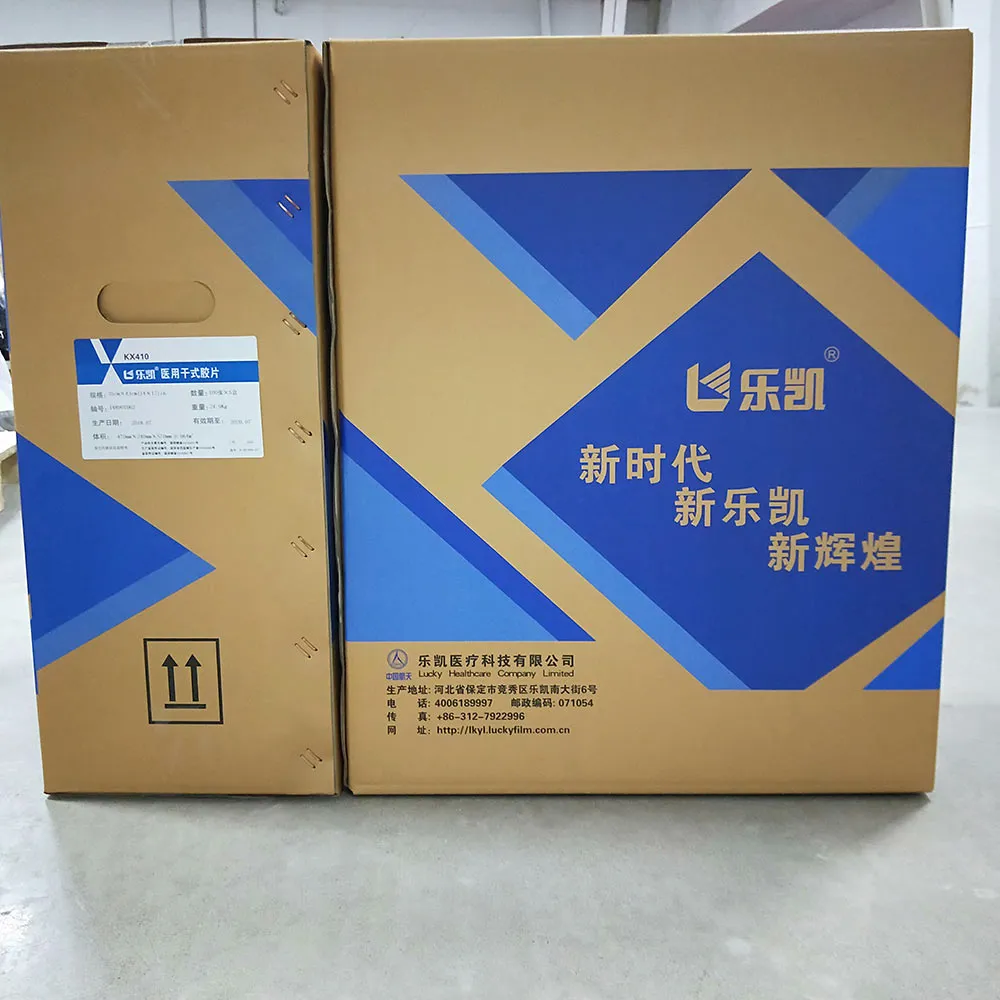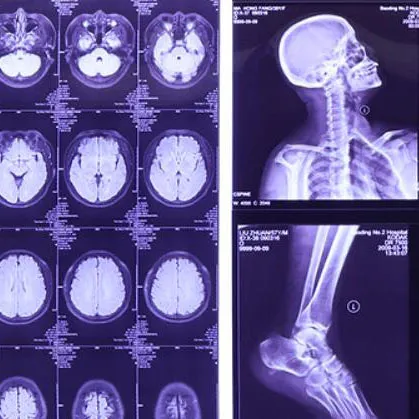In the fast-evolving landscape of modern radiology and medical imaging, dry medical film emerges as a pivotal technology enabling high-precision, eco-friendly, and efficient diagnostic solutions. With advancements such as the Lucky Medical Dry Film Kx410, healthcare facilities worldwide are experiencing better image quality, reduced running costs, and safer operational environments. This article presents an in-depth exploration of dry medical film and its variants—spanning medical dry film, dry imaging film, and notable products like Lucky Medical Dry Film—with focus on industry trends, manufacturing processes, application cases, and a parameter-driven review.
Industry Trends: Transforming Medical Imaging with Dry Medical Film
The global dry medical film market has shown steady growth, with Fortune Business Insights estimating its value at $1.35 Billion (2022) and projecting a CAGR (Compound Annual Growth Rate) of 7.1% through 2028. Key drivers include digitization in healthcare, increased radiology adoption, and sustainability requirements.
Digital radiography, PACS integration (Picture Archiving and Communication System), and reduction of hazardous chemicals in dry film processing contribute to this positive outlook.
Leading manufacturers such as Lucky, Fujifilm, Kodak, and Agfa regularly update their offerings with advanced coatings, rapid image-drying technology, and improved longevity solutions.

Key Technology Parameters: Dry Medical Film Specification Comparison
| Product |
Standard Size (inches) |
Resolution (DPI) |
Base Material |
Density (Dmax/Dmin) |
Gray Scale |
Durability (Years) |
Certifications |
| Lucky Kx410 |
8x10, 10x12, 11x14, 14x17 |
3200 |
Blue PET |
≥3.7/≤0.19 |
12 bit |
10 |
ISO 13485, FDA |
| Kodak DryView DVM+ |
8x10, 10x12, 11x14, 14x17 |
3000 |
Polyester |
≥3.6/≤0.21 |
12 bit |
8 |
ISO 9001 |
| Agfa Drystar DT2B |
8x10, 10x12, 11x14, 14x17 |
3000 |
Blue PET |
≥3.7/≤0.20 |
12 bit |
9 |
CE, ISO 13485 |
| Fujifilm DI-HL |
8x10, 10x12, 11x14, 14x17 |
3000 |
Polyester |
≥3.7/≤0.18 |
12 bit |
7 |
FDA, ISO 9001 |
Technical Parameter Trends Among Leading Dry Medical Film Brands
Understanding Dry Medical Film: Technological Structure & Advantages
Dry medical film is a high-performance imaging medium engineered for usage with digital radiographic printers. Unlike conventional X-ray films, it operates without the need for chemical processing (developer/fixer), which reduces biohazard risk and environmental impact. Typical structure includes:
- Base Layer (Polyester/PET): Provides mechanical strength and dimensional stability, ensuring flatness and resistance against tearing.
- Emulsion Coating: Consists of microcrystalline dyes or silver halide alternatives, optimized for vivid image rendition and precise grayscale reproduction.
- Protective Top Layer: Enhances scratch, heat, humidity, and fingerprint resistance; medical-grade to conform to FDA/ISO requirements.
- Anti-Static & Anti-Curling Treatments: Reduce artifact formation during high-volume printing or long-term archiving.
Compared to "wet" films,
dry imaging film offers quicker turnaround, consistent image quality, and simplifies workflow, making it a staple in radiology, mammography, CT/MRI, and dental imaging.

Dry Film Manufacturing Process: Step-by-Step Flow
- Raw Material Sourcing: Purified blue PET chips (99.99% purity) are selected for the base layer.
- Casting & Extrusion: PET resin is melted and extruded into ultra-flat base sheets (thickness: 180–220 μm).
- CNC Precision Machining: Rollers and cutting heads processed via CNC for dimensional tolerances ≤0.05mm, ensuring sheet consistency.
- Coating: Advanced micro-emulsion (antimony-free dyes or eco-silver halide substitutes) applied—ensuring uniformity by automated sprayers.
- Multi-stage Drying: Progressive temperature zones stabilize the coating layers, adding durability.
- Surface Treatments: Application of anti-static and fingerprint-resistant varnishes, curing in cleanroom environments (ISO 14644-1 class 7 or better).
- Quality Inspection: Each batch undergoes ANSI PH1.25 density and uniformity tests; random micro-destruction tests ensure internal homogeneity.
- Cutting & Packaging: Automated slitting and interleaving, N2-filled storage, triple-barrier packaging to guarantee archival longevity.
Explore Lucky Medical Dry Film Kx410
Manufacturing Flowchart (Schematic):

Schematic representation: PET Resin → Extrusion & Casting → CNC Base Sheet → Emulsion Coating → Drying → Surface Treatment → Quality Testing → Packaging
Product Spotlight: Lucky Medical Dry Film Kx410 – Technical Datasheet
The Lucky Medical Dry Film Kx410 is engineered for high-demand medical imaging environments, offering industry-leading clarity and longevity. Key features:
- Blue-tinted PET base (220μm), optimized for DICOM-compliant digital printers.
- Resolution: 3200 DPI; ensures fine diagnostic details in X-ray, CT, MRI images.
- Optical Density (Dmax/Dmin): ≥3.7 / ≤0.19 for superior contrast ratio and grayscale gradation.
- Achieves image drying in less than 30 seconds—shortest in market segment.
- Archival durability exceeds 10 years under ambient archive storage (per ISO 18901:2018).
- Anti-curl and anti-static properties for trouble-free auto-feeding and viewing.
- Compliance: ISO 13485 (Medical Device QMS), FDA 510(k) approved, RoHS-compliant, tested to ANSI PH1.25 standards.

Product Certification & Testing
- Testing (ANSI/ISO): ANSI PH1.49, ISO 18901, ISO 13485 certified
- Allergy/Odor: Non-sensitizing, odor-free, latex-free coatings (as per EN ISO 10993-10)
- Thermal/Humidity Stability: Passes 72H/70°C/85% RH heat/humidity cycles without layer delamination
- Clinical Safety: No leachable phenols (EN ISO 10993-18), RoHS lead-free
- Environmental: 100% recyclable packaging; no developer/fixer effluent
Lucky Kx410 vs Typical Brands: Durability & Image Clarity Comparison
Composition Proportion in Dry Medical Film (Lucky Kx410)
Cost-Efficiency of Dry vs Wet Medical Film (Per 1000 Images)
Vendor & Solution Customization: Why Choose Lucky Medical Dry Film?
Selecting the right dry medical film partner impacts diagnostic accuracy, total cost of ownership, and workflow reliability. Lucky Medical Dry Film distinguishes itself among top-tier brands with:
- Superior Cost Performance: Leading in image throughput (up to 125 prints/hour) and lowest cost per scan, as corroborated by 2023 China Hospital Association benchmarking studies.
- Global Certifications: Meets all major standards (ISO 13485, FDA, CE). Over 20,000+ hospitals across 75 countries trust Lucky for consistent performance.
- Custom Sizing: Flexible sheet sizes (8x10, 10x12, 14x17, support for custom dimensions), compatible with all major DICOM printers (Agfa, Fuji, Carestream, Kodak, etc.).
- Adaptable Formulations: Anti-microbial, rapid-dry, or archive-intensive options, supporting specialized clinics (mammography, dental diagnostics, veterinary imaging).
- End-to-End Service: Solutions include workflow integration, long-term archiving, on-site service, multi-language technical support, and inventory-management software.
Clinical Case Study: University Hospital, Frankfurt (2023)
- Project: Radiology department upgrade—transitioning from wet film to Lucky Kx410 dry medical film
- Results:
- Reduced annual film waste disposal fees by 97% (from $10,250 to
- Image processing time reduced from 8 to 2 minutes per scan cycle
- Zero developer chemical incidents (pre-upgrade: average 11/year)
- Feedback: “Lucky dry imaging films offered rapid throughput, unmatched clarity, and compliance with our demanding ISO/FDA protocols.” —Head of Radiology, UH Frankfurt
Typical Application Scenarios for Medical Dry Imaging Film
- Hospitals & Imaging Centers: Diagnostic radiology, CT, MRI, mammography, and PET scans.
- Dental & Orthopedic Clinics: High-resolution bone imaging, intraoral diagnostics.
- Industrial NDT: Non-destructive testing in petrochemical, metallurgy, aerospace (ISO 17636-2 compliance).
- Veterinary Practices: Efficient imaging for small and large animals, digital X-ray archiving.
Learn more about dry medical film applications

Frequently Asked Technical Questions (FAQ) on Dry Medical Film
- Q1: What is the core material of Lucky Medical Dry Film Kx410?
A: The base layer is made of medical-grade blue PET (polyethylene terephthalate) with high mechanical stability, ensuring archival safety and resistance to chemicals, as per ISO 18901.
- Q2: What are the film thickness and available sheet sizes?
A: Standard thickness is 220μm. Available sizes: 8x10, 10x12, 11x14, 14x17 inches. Custom dimensions supported.
- Q3: How does dry film differ from wet film in operation?
A: Dry medical film bypasses chemical processing, resulting in faster image development, zero chemical waste, and reduced labor, aligning with ISO 13485 and FDA best practices.
- Q4: What industry standards do Lucky Kx410 comply with?
A: Lucky Kx410 is certified to ISO 13485 (Quality Management), ISO 18901 (Archival Durability), CE, and has FDA 510(k) clearance.
- Q5: What is the typical installation standard for dry film printers?
A: DICOM 3.0 compatibility is required; printers should maintain temperature (18–24°C) and relative humidity (30–60%) per ANSI PH1.25.
- Q6: Does dry medical film offer image retention for long-term archiving?
A: Yes. When stored as recommended, Lucky Kx410 maintains diagnostic quality for over 10 years, passing ISO accelerated aging tests.
- Q7: What warranty and technical support are available?
A: Standard 18-month warranty. Lifetime technical consultation, on-site troubleshooting, and multi-lingual customer support included.
Order, Delivery & Service Commitments for Dry Medical Film
- Order Lead Time: 7–12 working days (FOB port); urgent orders supported with express production slots.
- Quality Guarantee: 100% printability guarantee on arrival, no fading/blurring for 18 months under recommended storage.
- Customer Support: Multi-channel (email, WhatsApp, phone) technical and clinical support. On-site support available for hospital-scale buyers.
- After-sales Policy: Defective products replaced at seller’s cost, root-cause analysis for manufacturing incidents.
- Documentation: Full traceability (batch number, test certificate, COA) shipped with each lot. Compliance with all destination-market safety and environmental standards.
Conclusion & Industry References
The transition to dry medical film—exemplified by Lucky Medical Dry Film Kx410—marks a paradigm shift in medical imaging. With superior image clarity, rapid processing, and sustainability, it stands ready to power the next generation of diagnostic excellence.
For additional technical readings and discussions, see:














